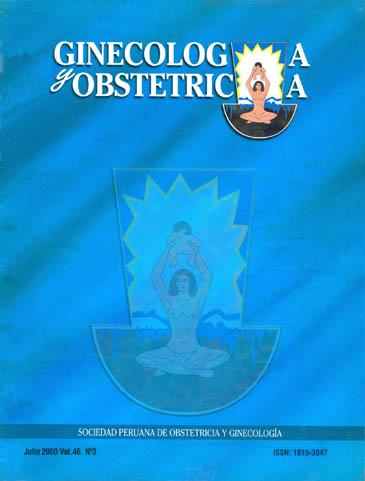HELLP syndrome.
DOI:
https://doi.org/10.31403/rpgo.v46i1416Abstract
OBJECTIVE: To describe the clinical characteristics and perinatal maternal complications of HELLP syndrome. DESIGN: Retrospective descriptive. MATERIALS AND METHODS: Cases of HELLP syndrome treated at the National Hospital Guillermo Almenara lrigoyen (HNGAI) in 1999. RESULTS: The incidence of HELLP syndrome was 16.3 per 1,000 live births, 16 (41%) with complete criteria and 23 (58.9 %) with partial HELLP. epigastric and right upper quadrant pain in 46.2% of patients were recorded, partnering with more thrombocytopenia (OR = S. p <0.001), major obstetric complications were DIC 17 (43.6%), acute respiratory failure 14 (35. 9%), placental abruption 9 (23.1%) and eclampsia four (10.3%). complications in partial HELLP were lower. Gestation was completed in 63% of patients between 33 and 37 weeks, 95% by cesarean section. blood products was used in 67%, according to the severity of thrombocytopenia. Perinatal morbidity consisted of 28 (76%) preterm and 19 (51%) infants of low birth weight. Maternal mortality was 0% and 14% perinatal latter is associated with prematurity (OR = 10, p <0.005). In the evolution of thrombocytopenia there was a maximum writing within 48 hours after birth, spontaneous platelet recovery to seven days. Corticosteroids exert a beneficial effect on the advancement of this recovery. CONCLUSlÓN: The HELLP syndrome is an entity of high maternal and perinatal morbidity and mortality. Obstetric complications are associated with greater thrombocytopenia, while perinatal prematurity. Medical management and surgical intensive care support reduce the complications associated with this entity.Downloads
Download data is not yet available.
Downloads
Published
2015-07-17
How to Cite
Arana, C., & Donayre, A. (2015). HELLP syndrome. The Peruvian Journal of Gynecology and Obstetrics, 46(3), 222–227. https://doi.org/10.31403/rpgo.v46i1416
Issue
Section
Artículos Originales
















